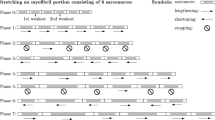Summary
A high resolution, time efficient method is described for determining the complex modulus of activated striated muscle. In this method the applied oscillation of muscle length takes the form of pseudo-random binary noise, PRBN. As a time-domain signal, PRBN is an extension of the double step approach to includen steps; as a frequency-domain signal, PRBN has the properties of quasi-white noise. Fourier analysis of the PRBN length oscillations and the resulting interrupted tension transients gives rise to the complex modulus values. PRBN provides a practical demonstration of the conceptual link between time and frequency domain descriptions of strain sensitive dynamics. The method is demonstrated with intact rat papillary muscle, and glycerol extracted rabbit psoas muscle.
Similar content being viewed by others
References
Abbott, R. H. (1973) The effects of fibre length and calcium ion concentration on the dynamic response of glycerol extracted insect fibrillar muscle.J. Physiol., Lond. 231, 195–208.
Abbott, R. H. &Steiger, G. J. (1977) Temperature and amplitude dependence of tension transients in glycerinated skeletal and insect fibrillar muscle.J. Physiol., Lond. 266, 13–42.
Bendat, J. S. &Piersol, G. (1971)Random Data; Analysis and Measurement Procedures. New York: Wiley-Interscience.
Briggs, P. A. N., Godfrey, K. R. &Hammond, P. H. (1967) Estimation of process dynamic characteristics by correlation methods using pseudo random signals.IFAC Symposium on Identification in Automatic Control Systems, Prague, 1–12.
Brigham, E. O. (1974)The Fast Fourier Transform. Englewood Cliffs, New Jersey: Prentice Hall.
Cuminetti, R. &Rossmanith, G. H. (1980) Small amplitude non-linearities in the mechanical response of an asynchronous flight muscle.J. Musc. Res. Cell Motility 1, 345–56.
Davies, W. D. T. (1966) Generation and properties of maximum-length sequences.Control 10, 302–4.
Halpern, W. &Alpert, N. R. (1971) A stochastic signal method for measuring dynamic mechanical properties of muscle.J. appl. Physiol. 31, 913–25.
Huxley, A. F. &Simmons, R. M. (1971) Proposed mechanism of force generation in striated muscle.Nature, Lond. 233, 553–8.
Huxley, A. F. &Simmons, R. M. (1973) Mechanical transients and the origin of muscular force.Cold Spring Harb. Symp. quant. Biol. 37 661–8.
Uno, M. &Simmons, R. M. (1982) Tension responses to double step length changes in frog skinned muscle fibres.J. Physiol., Lond. 332, 54-5p.
Kawai, M. &Brandt, P. W. (1980) Sinusoidal analysis: a high resolution method for correlating biochemical reactions with physiological processes in activated skeletal muscles of rabbit, frog and crayfish.J. Musc. Res. Cell Motility 1, 279–303.
Rossmanith, G. H. (1977)Frequency-domain analysis and parameter identification of muscle substructures. PhD. Thesis, Macquarie University.
Rossmanith, G. H., Hoh, J. F. Y., Kirman, A. &Kwan, L. (1986) Influence of V1 and V3 isomyosins of the mechanical behaviour of rat papillary muscle as studied by pseudo-random binary noise modulated length perturbations.J. Musc. Res. Cell Motility 7 307–19.
Rossmanith, G. H., Unsworth, J. &Bell, R. D. (1980) Frequency-domain study of the mechanical response of living striated muscle.Experientia 36, 51–3.
Sagawa, K., Saeki, Y., Loeffler, L. &Nakayama, K. (1979) Dynamic stiffness of heart muscle in twitch and contracture. InCross-bridge Mechanism in Muscle Contraction (edited bySugi, H. andPollack, G. H.), pp. 171–90. Tokyo: University of Tokyo Press.
Steiger, G. J. (1977) Stretch activation and tension transients in cardiac, skeletal and insect flight muscle.In Insect Flight (edited byTregear, R. T.), pp. 221–68. Amsterdam: North Holland.
Steiger, G. J. (1978) Kinetic analysis of isometric tension transients in cardiac muscle. In cross-bridge mechanism in muscle contraction (edited bySugi, H. andPollock, G. H.), pp. 259–71. Tokyo: University of Tokyo Press.
Thorson, J. &White, D. C. S. (1969) Distributed representations for actin-myosin interaction in the oscillatory contraction of muscle.Biophys. J. 9, 360–90.
White, D. C. S. &Thorson, J. (1972) Phosphate starvation and the non-linear dynamics of insect fibrillar flight muscle.J. gen. Physiol. 60, 307–36.
White, D. C. S. &Thorson, J. (1973) The kinetics of muscle contraction.Prog. Biophys. molec. Biol 27, 173–255.
Author information
Authors and Affiliations
Rights and permissions
About this article
Cite this article
Rossmanith, G.H. Tension responses of muscle ton-step pseudo-random length reversals: A frequency domain representation. J Muscle Res Cell Motil 7, 299–306 (1986). https://doi.org/10.1007/BF01753650
Received:
Revised:
Issue Date:
DOI: https://doi.org/10.1007/BF01753650




